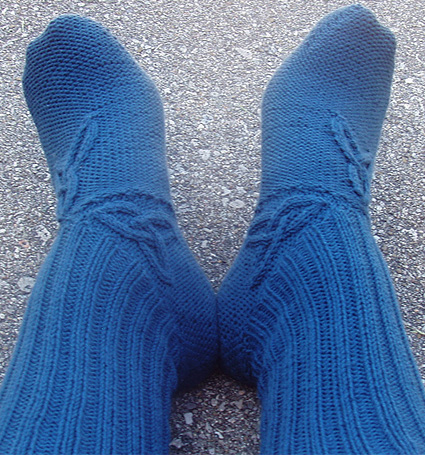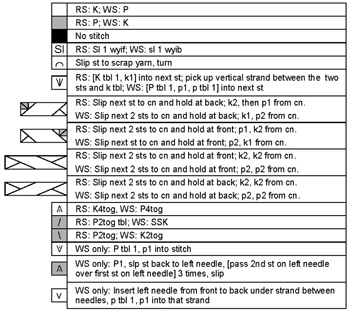

|
|
|
 |
Some time ago, I devised a different way of doing socks: heel-out. You start by making what is essentially a tiny hat for your heel, then two gussets which are like earflaps for the ‘hat’. Each gusset tapers to a point at the top of the instep, and you join the points of the two gussets together. You work stitches around one side of the gussets to make the foot, and then work stitches around the other side of the gussets to make the leg (see illustration below). I called this construction the Hat-heel Sock. I love this way of making socks, and churned out loads of pairs. However, they were all in plain stockinette stitch, and I wanted to be able to make fancier socks – spice up the basic construction by using cables, lace, colorwork, etc. |
This is the first such variation: the triangular gussets at the sides of the foot contain triangular cable motifs. I think this makes the socks fancy in an understated way. And if you want more fanciness, there’s an optional additional cable pattern you can do on top of the foot, which will give the sock a triskelion of triangles: three tri-pointed cabled motifs, all meeting at a point at the top of the instep. Another difference from the original hat-heel pattern is the method of gusset shaping: short rows instead of decreases. This makes the socks much stretchier around the gusset sides. Thanks very much to Chris Wass, whose modification of the original hat-heel was the inspiration for this change. These socks have the added advantage of being mostly reverse stockinette stitch all over the foot, which means that you have the smooth stockinette stitch side on the inside, touching your skin – very comfortable! |
|
|
SIZE |
|
FINISHED MEASUREMENTS |
|
MATERIALS Notions |
|
GAUGE |
| 32 sts/44 rounds = 4 inches in stockinette
stitch |
|
PATTERN NOTES |
|
The construction of this sock is unique, and involves collecting stitches in a very particular way to start the foot and the leg. The following diagram should help clarify the idea if you get stuck during the pick-up:
M1: From back-to-front, insert the right-hand needle into the stitch below the next stitch on the left-hand needle (see step 1 photo at right), and transfer it directly onto the left-hand needle (see step 2); K this new st through the back loop (see step 3) Judy’s Magic Cast-on is recommended to start with. This pattern is very specific about how stitches are held – some stitches are slipped to scrap yarn, some to safety pins, and some to stitch holders. Follow these instructions carefully, as they are to help you identify which stitches you’re working with at specific times. The majority of the stitches in the heel and foot of these socks are purls (reverse stockinette stitch). Since it is generally considered easier to knit in the round rather than purl in the round, you will be working a lot of the sock inside-out, with the WS facing you (i.e. the knit stitches), and the RS on the inside of the sock (i.e. the purl stitches). This can make things a little tricky, so be sure to read instructions carefully and pay close attention to the difference between RS instructions and WS instructions on the chart legend. Additionally, there are instances where you will work a chart opposite to the usual direction. These are noted in the instructions. Because these socks are mostly reverse stockinette stitch, the gusset seams can end up looking a bit messy depending on how the stitches are picked up. Best results were achieved using Theresa Vinson Stenersen’s technique for picking up along a slipped-stitch edge. There are two options for doing the foot on these socks – with a third cable motif at the top, or without. This is noted in the pattern. This pattern recommends grafting the work closed at the
toe. Grafting is also referred to as the Kitchener
Stitch.
|
 |
|
DIRECTIONS Round 1: Knit all sts. Man size only: Both sizes: Note: Remember, when reading the gusset chart, that when the knit side of the work is facing you, you are looking at the WS, and when the purl side of the work is facing you, you are looking at the RS. For RS rows, you will be reading the chart lines right-to-left, and for WS rows, you will be reading the chart lines left-to-right. The gusset chart requires you to cable on both RS and WS rows, while simultaneously doing short rows on two out of every three rows. You will therefore need to devote a fair bit of concentration to reading the chart accurately. To help you follow the chart, it is recommended that you slip the unworked stitches from the short rows onto two spare lengths of yarn (one length of yarn for each side of the gusset) as you go. Once you’re done with each gusset, tie the ends of each length in a loose knot so the stitches don’t slide off. First Gusset (worked flat) Second Gusset (worked flat) You will now be working in the round again, still with WS facing, and starting from where you left off at ** (the next st to work is the one to the immediate left of the st which has the working yarn trailing from it). The first step is to prepare the sts you'll need for working the foot in the round; if you get stuck during this process, refer to step 3 in illustration above. It is quite fiddly work. Some of the sts you will use in the foot will come from stitch holders; some will come from spare lengths of yarn; and some will need to be picked up. Note that because you are still working with the WS facing, you need to pick up sts so that they look good from the other side! Setup round: Round 1 [WS]: K22[25], pm; reading from left-to-right,
work row 1 of Chart C[D], pm, k22[25].
For ease of working, rearrange your sts so that your
Chart C[D] stitches are all on the same needle – just
make sure that the location of the beginning of the
round stays in the same place. The markers are there
to indicate the beginning and end of the chart sts.
If you don’t need the markers,
remove them. Both options Set up for Toe Decreases Initial Decreases Woman size only: proceed to Secondary Decreases. Toe round 9: [SKP, k-[20], k2tog] twice. Secondary Decreases Man size only: Toe completion: Turn the work inside-out so that the RS is facing outwards. From this point on, you will be working in the round with the RS facing. The first step is to get all the sts ready that you will need for working in the round; if you get stuck during this process, refer to step 4 in illustration above. It is quite fiddly work. As with the setup round for the foot, some of the sts you will use for the leg will come from stitch holders; some will come from spare lengths of yarn; and some will need to be picked up. Note: because you are now working with the RS facing, you need to pick up sts so that they look good from the side you are looking at! Setup round: Mark for beginning of the round. This is the center
back of the heel. Cast off in established 2x2 rib pattern using Jeny’s Surprisingly Stretchy Bind-off. |
|
FINISHING |
| ABOUT THE DESIGNER |
|
Kathleen hasn’t knitted “regular” socks for almost
two years. She continues to look for new variations for hat-heel
socks and hopes others will do the same.
She is also trying valiantly but fruitlessly
to keep her WIPs under some semblance of
control. |
|
Pattern & images © 2010 Kathleen Sperling. Contact Kathleen |